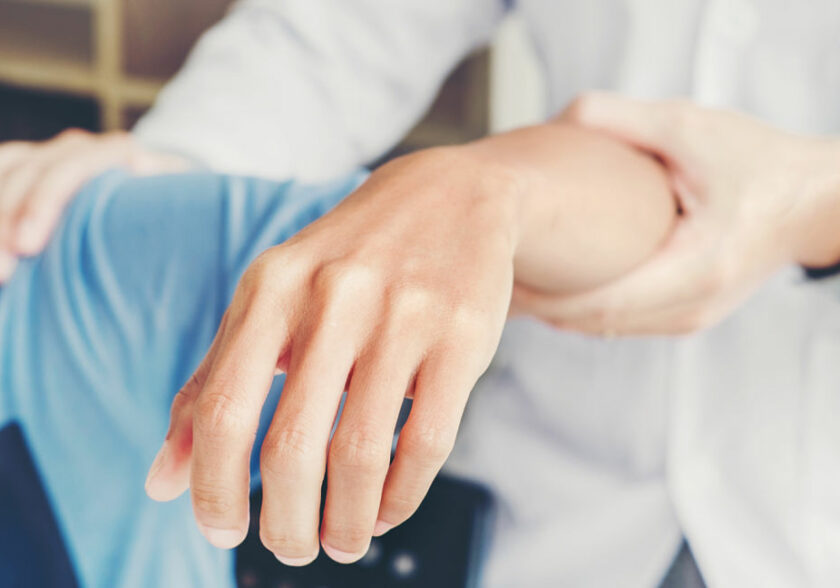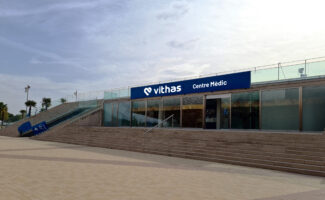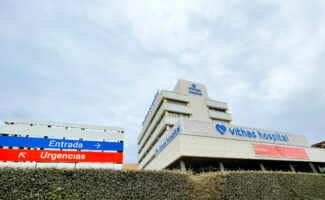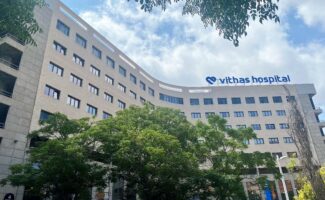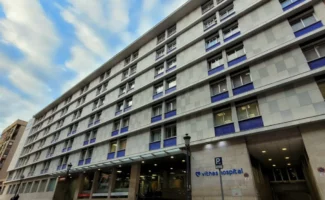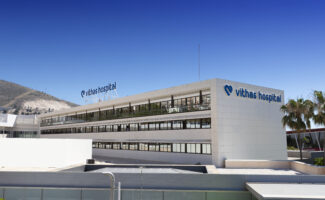What is physical therapy?
According to the World Confederation of Physical Therapy, physical therapy is “the set of methods, actions and techniques that prevent, recover and adapt people affected by somatic dysfunctions or people wanting to maintain an adequate level of health by applying physical means”.
Vithas’ Physical Therapy Clinic aims to facilitate the maximum development, maintenance and recovery of patients’ functionality and mobility.
Vithas centres specialise in treatments based on manual therapy, electrotherapy and magnetotherapy, among other techniques.
Which patients is it for?
Physical therapy can be used in all clinical specialities where indicated, either as a sole treatment or in combination with pharmacology and other therapies:
- Obstetric and gynaecological physical therapy: pre- and postpartum re-education, urinary incontinence.
- Paediatric physical therapy: brachial palsy, obstetric palsy, bronchiolitis, arthrogryposis, early care, congenital torticollis treatment and infant colic treatment.
- Vascular system physical therapy, amputee care, lymphatic and venous drainage, etc.
- Neurological physical therapy: sciatica, disc hernia, hemiplegia, multiple sclerosis, Parkinson’s, neurological paralysis, TBI, spinal cord injury, etc.
- Geriatric physical therapy: loss of mobility and functionality in elderly patients.
- Respiratory physical therapy: COPD, cystic fibrosis, lobectomy, etc.
- Trauma and orthopaedic physical therapy: sprains, fractures, dislocations, muscle breaks, sports injuries, spinal deviations, postoperative recovery.
- Rheumatological physical therapy: osteoarthritis, arthritis, fibromyalgia, calcifications, osteoporosis, spondyloarthritis, etc.
- Cardiological physical therapy: exertion re-education for cardiac patients.
- Coloproctological physical therapy: incontinence, etc.
- Others: Physical therapy for burn patients, stress treatment, migraines, etc.
Main conditions and diseases
The physical therapy clinic treats the following conditions:
- Musculoskeletal pain
- Spine deformities
- Ligament, joint, bone and muscle injuries
- Injuries
- Digestive and uro-gynaecological ailments and disorders
- Neurological lesions
- Dizziness, headaches, migraines, etc.
- Chronic pain
- Temporomandivular dysfunctions
- Post-surgical recovery
- Sports recovery
- Pelvic floor strengthening
Main diagnostic resources and technology
Treatments are based primarily on manual techniques that offer the best access to the injury at all times. We also have instruments (ultrasound, electrotherapy, thermotherapy) for any techniques we cannot perform manually.
We use all kinds of techniques, including kinesitherapy, electrotherapy, massage therapy, osteopathy, acupuncture, dry puncture, myofascial release, MLD, neuromuscular bandaging and kinesiotaping.
Main treatments
- Lymphatic drainage
- Electrotherapy
- Magnetoterapy
- Osteopathy
- Global postural re-education
Areas of specialisation
The main physiotherapeutic subspecialties we offer at Vithas are:
- Sports physical therapy: muscle overload, sprains, fibrillary ruptures, strains, etc.
- Trauma physical therapy: Post-surgical treatments, disc hernias, cervical pain, lower back pain, joint and/or muscle disorders, fractures, etc.
- Rheumatological physical therapy: Arthritis, osteoarthritis, fibromyalgia, rheumatological disorders, etc.
- Neurological physical therapy: stroke, TBI, hemiplegia, spasticity, hypotonia, paraplegia, peripheral neurological disorders, etc.
- Paediatric physical therapy: Early stimulation, congenital torticollis, Perthes’ disease, psychomotor development disorders, neurological alterations, etc.
- Pelvic floor physical therapy: Prevention and treatment of dysfunctions caused by bad conditions or malfunctions of the pelvic floor and abdominal area.
- Pre- and post-partum or obstetric physical therapy: concerned with assessing, preventing and treating the different dysfunctions that appear during and after pregnancy.
- Respiratory physical therapy: concerned with the prevention, treatment and stabilisation of breathing dysfunctions or alterations to improve regional lung ventilation, gas exchange, the function of the muscles involved in breathing, dyspnoea, or exercise tolerance, among other respiratory problems.
Special services
Vithas offers you high-quality medical care, performing the necessary studies to establish an adequate diagnosis, treatment and follow-up of each patient's specific conditions. We believe that by offering quality physiotherapy we are able to guarantee the best results for our patients, and we have built our way of working around this idea.
For the duration of your treatment, you will be treated personally by a registered physiotherapist to help you understand and solve your problem. We are confident that understanding the origin of the injury and understanding your treatment are two pillars for effective recovery. During the sessions, you will be explained how to understand and take care of your body.
We should not think that the only effective treatments to cure an injury are painful ones. A patient comes to be cured, not to suffer. As such, we will always choose the least painful treatments and if we do need to use more aggressive techniques, we will always get your authorisation, taking into account your pain threshold.
We believe that injury is not only cured by eliminating pain, but we have to go further. We should look at the body globally and solve the problem from its origin to ensure it can be healed correctly and completely.
In all our sessions we perform measurements and tests before and after the treatment so that you can numerically and graphically observe your evolution.
FAQs
What is physical therapy?
Most people when talking about physical therapy think of massages and to a lesser extent of manual therapies, associating it mainly with the field of traumatology, such as treating tendonitis, ankle sprains, cervical contractures, etc. However, physical therapy covers all fields of health care. It helps to recover not only the function of the muscular and skeletal system but of all body systems, seeking to prevent and treat injury and maintain patients’ health and well-being.
Why does my back hurt?
Most physiotherapy visits are related to spinal ailments. Acute cases are usually caused by sudden and improper movements, for example:
- Incorrect daily gestures such as abruptly standing up lowered position or lifting heavy objects improperly.
- Sports injuries.
- Traumatic accidents (sprains, fractures, etc.).
Chronic cases can be caused by all manner of factors, including:
- Microtraumas, which appear as a result of repetitive movements.
- Unbalanced static loads.
- Long phases of inactivity and sedentary lifestyle.
- Spine dysfunctions, triggered reflexively by alterations in the functioning of an organ.
- Psychic and emotional burdens. Muscle tensions react to psychic stimuli, especially stress in areas of greater weakness or overuse.
- Metabolic disorders.
- Neurological problems.
- Degenerative diseases.
The incidence of lower back pain is very high. It is the second most common cause of absenteeism at work and the first cause of physical limitation in people under 45 years of age. Lumbar pain affects between 70 and 85% of the population throughout their lives. This pain can appear intensely from the outset or gradually increase in intensity, becoming limiting.
How can I prevent back pain?
Prevention and regular back care is the best treatment to avoid injuries and maintain good spinal health throughout life.
Following the example of lower back pain, doing a specific and individualised programme of therapeutic exercise (physiopilates, hypopressive abdominal gymnastics, back school, yoga) along with aerobic exercise (swimming, walking, etc.) will improve your physical condition as unlike other injuries, lower back pain does not improve with rest.
Exercise strengthens the lumbar and abdominal muscles, providing stability and movement and preventing new episodes.
Physical therapy offers an optimal treatment for back pain due to the number of physical techniques with which the problem can be addressed, both during acute episodes and in chronic problems or to keep the back healthy despite the toll everyday life can take on it.
Pelvis floor unit
Specialised pelvic floor physical therapy works in conjunction with the fields of uro-gynaecology, obstetrics and coloproctology. Its aim is to prevent and treat dysfunctions caused by bad conditions or malfunctions of the pelvic floor and abdominal area. Uro-gynaecological, obstetric and coloproctological physical therapy is aimed at women and men, both to prevent and treat conditions related to the pelvic floor and abdominal area.
The pelvic floor is the set of muscles and ligaments responsible for supporting the pelvic organs in the correct posture within the abdominal-pelvic cavity and surrounding the bladder neck, rectum, and vagina (in women).
What can impair the functioning, tone and/or strength of the pelvic floor?
- Pregnancy and childbirth
- Age
- Impact sports or sport with increased intra-abdominal pressures
- Surgical interventions: prostatectomy, hysterectomy, etc.
- Menopause and ageing
- Hereditary factors
- Others: chronic constipation, chronic cough, obesity, hyperpressive abdominal exertion (strength work), etc.
The most frequent problems that can occur when this musculature and abdominal and perineal tissues are impaired are:
- Urinary incontinence
- Faecal and/or gas incontinence
- Pelvic organ prolapses: Cystocele, hysterocele, rectocele
- Sexual dysfunction due to pain or hypotonia
- Constipation, anal fissures
- Chronic pelvic pain
Due to their anatomical design, hormonal changes, pregnancy and childbirth, women tend to have more conditions caused by pelvic floor injury, hypotonia or hypertonia, but men can also have pelvic floor dysfunctions, especially after a radical prostatectomy. In any case, these problems can be prevented, treated, cured or improved significantly with specialised physical therapy programmes.
It is highly recommended to undergo preventive treatment prior to pelvic cavity surgeries, such as a hysterectomy or prostatectomy, to prevent potential problems, improve the postoperative period, and ensure better long-term outcomes after surgery.
The essential preventive and treatment programme to improve or prevent the appearance of problems would be:
- Specialised birth preparation
- Postpartum recovery
- Postmenopausal pelvic floor recovery
- Pre- and post-surgical pelvic floor rehabilitation
- Pelvic floor recovery at any stage where you suspect you may have a problem or want to prevent one
Treatment techniques:
- Electrostimulation and biofeedback
- Manual therapy Perineal trigger points
- Myofascial therapy
- Posterior tibial nerve neuromodulation
- Hypopressive abdominal techniques
- Rectal balloon therapy
- Specific exercises for postural re-education and abdominoperineal toning


